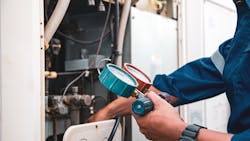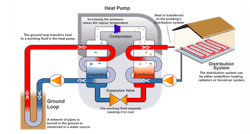The new tools of war are drones and energy. Russia is using both, the first against Ukraine, the second against Europe. The task for the Ukrainians is to expel this aggressor, and the challenge for the Europeans is to become energy independent. This is urgent, not only because Europe's oil and gas purchases pay for operating the Russian war machine, but also because their energy storage is running low, and the winter is here. Therefore, new energy supplies are quickly needed.
In this column, I will show how heat pumps can help to meet this need and how our process control profession can automate and optimize such a system.
Heat pumps use a working fluid to move heat from a low to a higher temperature level. This working fluid, having a low boiling point, evaporates into a low-pressure gas as it picks up heat from the surroundings that are relatively cold, but warmer the boiling point of the fluid. The gas, after being compressed, carries that heat obtained in the evaporator into a condenser where it is released into the warm heated surroundings of the heat pump. The air conditioner is such a device as it removes heat from our cooled buildings and rejects it into the relatively warm air outside. If, in the winter, the flow direction of the working fluid is reversed, the air conditioner can move the heat contained in the cold outside air into our homes and heat them (Figure 1).
In the U.S., as we move from north to south, the efficiencies of heat pumps used for heating in the winter increase. In the south, sizing a winter heat pump, the beat capacity needed per square foot is about 30 BTU (kW/h = 3,410 BTU) and in the north, about 60 BTU (in Connecticut it is about 45 BTU/ft2). So, one weapon the EU members can readily use to weaken Putin's blackmail is to change the working fluid in their A/C units and install a reversing valve around their compressor (or just buy a new two-directional A/C unit).
The heat demand of the district is the sum of all the supply valves in it. A high signal selector selects the control signal that throttles the most open valve and sends it to a valve position controller (VPC) which compares that % opening with it's set point of 90% and throttles the P2 pump speed, which(increases the total district supply pressure to keep the most open valve from opening beyond 90%. and operates, keeps the openings of all under that value. The The flow in the district heating loop (F2) indicates the heat load on the district and informs the flow ratio controller (FrC), which throttles the ground loop (P1) speed to continuously hold the heat pump load (F1) at the optimum ratio with the district load F2) Finally, the speed of the compressor is throttled by the district supply temperature controller (TC) having a set point, which is continuously optimized by the overall system algorithm to keep the total cost of operation at a minimum.
About the Author
Béla Lipták
Columnist and Control Consultant
Béla Lipták is an automation and safety consultant and editor of the Instrument and Automation Engineers’ Handbook (IAEH).

Leaders relevant to this article:





